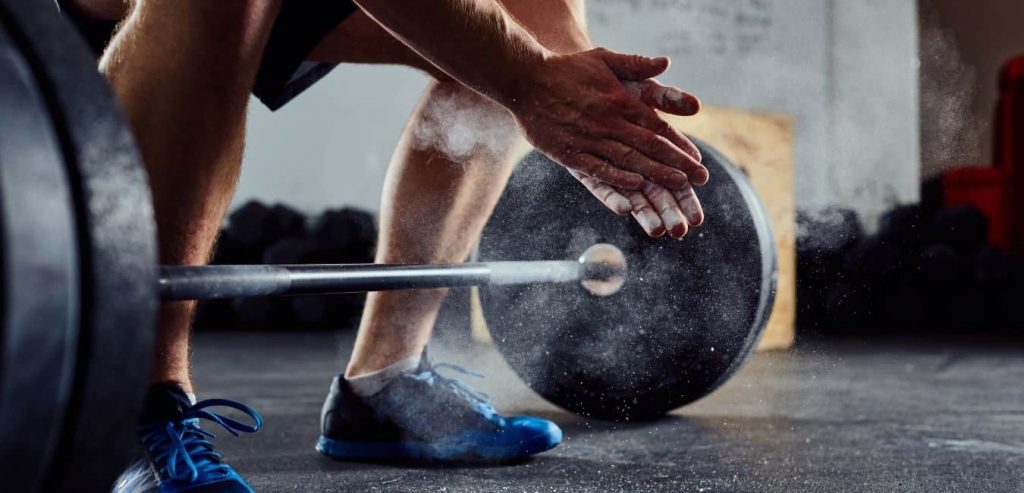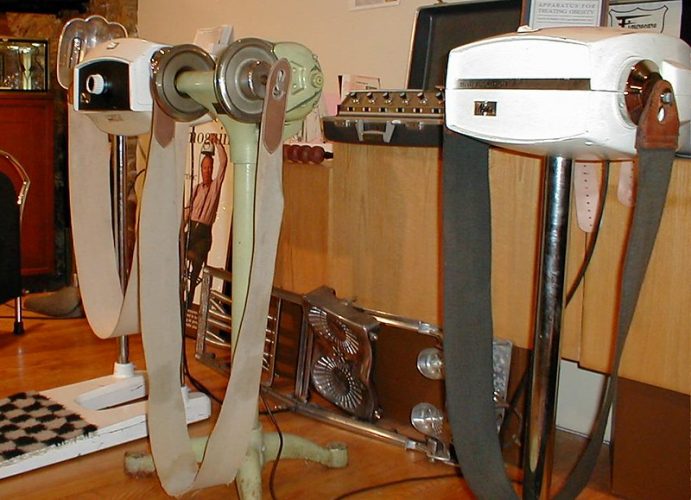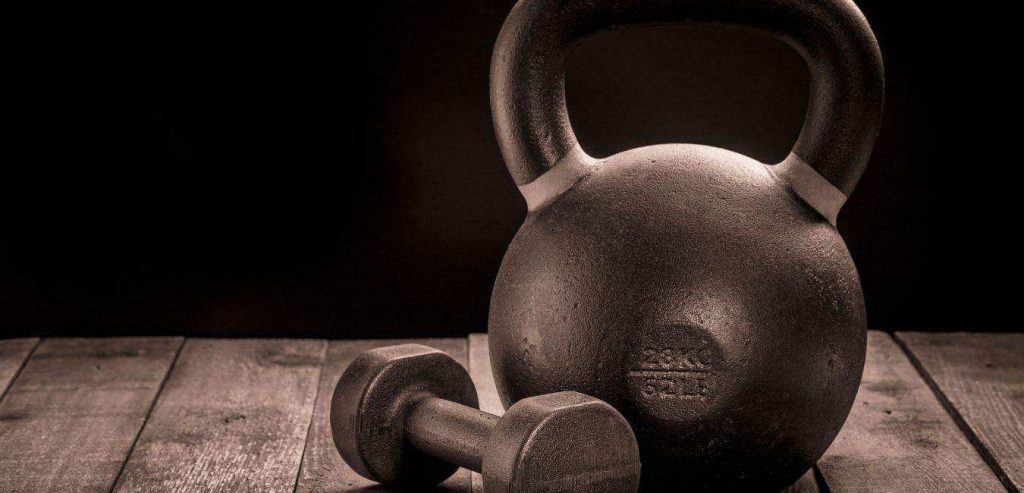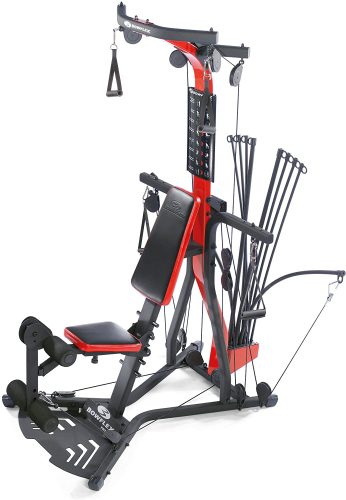We’ve come a long way since the electricity belt.
Resistance training is an old concept. The Greek wrestler Milo of Croton allegedly developed his massive physique by carrying a bull on his shoulders, snapping resistance bands, and crushing things with his bare hands. In letters to his son, Benjamin Franklin recommended daily use of the dumbbell, performing 40 repetitions per day well into old age. Theodore Roosevelt, frail and asthmatic in his youth, strengthened his torso by using a crude, 19th-century forebear of the Bowflex machine.
If space is your concern, buy a set of 55-pound York dumbbells and put them under your bed. From thrusters to modified kettlebell swings, there’s not much you can’t do with a pair of York 55s.
By the beginning of the 20th century, many devices were available for purchase, most obtainable through America’s burgeoning mail-order industry. As an increasingly affluent population met its basic needs and began addressing its wants, purveyors of fitness equipment converted the public’s worries and desires into profit.
Some of these forms of equipment, such as barbells and kettlebells, have stood the test of time and remain the foundation of any well-designed exercise regimen. Like the electricity belt and the vibrating belt machine, others have proven ineffective but occasionally experience brief, faddish resurrections.
This is probably because fitness equipment appeals to our inner need for structure and organization, whether good or bad. Although tossing hay bales and stocking produce during my teenage years yielded a good workout in some difficult-to-quantify sense, I never felt like I was progressing toward anything. Only after discovering Nautilus machines, dumbbells, and other devices did I believe I was proceeding systematically toward a clear objective—even during those long stretches of time when I wasn’t.
Here, then, is an overview of some of the major developments in fitness equipment during the past century. Not everything worked, but the failures are often just as memorable as the successes. And as we head toward beach season, perhaps one or more of these pieces of equipment will help you sculpt your body into good enough shape to remove your shirt in front of other people this summer.
Electricity Belts

What it is
Mankind’s harnessing of electric current was viewed as one of the great breakthroughs of the 19th century, and electricity appeared to offer untold future benefits.
Canny entrepreneurs recognized this, and devices such as the Heidelberg Electric Belt (listed at a relatively pricey $18 in the 1903 Sears, Roebuck & Co. catalog, as seen above) promised to remedy “weaknesses peculiar to men,” thereby resulting in “a vigor induced, a tone returned, a joy restored that thousands of dollars worth of medicine and doctors’ prescriptions would never give.”
The Fortis Electric Exerciser was a pulley-and-weight machine that sent a mild electrical current through the user’s body, a “magical effect” that was supposed to alleviate everything from rheumatism to neuralgia. More recently, a host of newfangled electrical stimulation belts have hit the market, promising to sculpt rock-hard abdominals and promote fat loss.
Does it work?
Research has shown that a handful of extremely well-designed belts, such as the Slendertone, can effect a modest increase in abdominal strength when used regularly. However, the belts are utterly ineffective at promoting fat loss and do not work on abdomens that are covered in fat.
Worse still, most of the products in this category are pure quackery, with many belts designed only to make buzzing sounds that give the illusion they’re working properly. The devices can also interfere with pacemakers, so people with heart conditions—who might be drawn to the belts because they’re low impact—should avoid using them.
Fun fact
The Amazon reviews for these products make for amusing reading. “Couldn’t tell if it works plus burns your skin and may shock you”, wrote a reviewer of the Ab Gymnic Belt (who nonetheless awarded it two stars, perhaps because it costs a mere 15 bucks).
Users of the “FDA-approved” Sport-Elec Body Control System reported that it burns the skin while burning through batteries.
More: The Best Treadmills Under $500
Barbells

What it is
A barbell is a long bar, usually 2.2 meters (7.2 feet) in length and 20 kilograms (44 pounds) in weight, to which weight plates are attached via collars at its ends. According to sports historian Jan Todd, the earliest barbells began appearing in the 1860s.
However, their dimensions weren’t standardized until the early 20th century. The various lifts developed alongside the barbell itself, with the Olympic lifts—press, clean, snatch—predominant until the powerlifting revolution of the 1960s.
Does it work?
Absolutely. Everyone from bodybuilding trainers such as Mike Mentzer to CrossFit devotees like Rich Froning concedes that barbell exercises, when performed properly, are the key to developing strength.
Such exercises enable trainees to track their ability to move increasingly heavy weights over the course of a training program, can be practiced repetitively until form issues are ironed out, and have withstood the test of time. Almost all of the incredibly strong athletes of the 20th century trained with barbells at some point during their careers.
Fun fact
The bench press, now the most common barbell lift practiced by men, was a little-known exercise until the 1940s. Before then, “how much can you bench?” wasn’t nearly as important as “how much can you [shoulder] press?” Many early bodybuilding competitions required that competitors in various weight classes complete a shoulder press at a certain weight (often 200 pounds) before allowing them to participate.
More: The Best Trampoline For Adults
Vibrating Belt Machines

What it is
Vibrating belt machines conjure up images of obese 1920s ballplayers detoxing their way into shape at health camps and ridiculous Looney Tunes cartoons set in gyms. They’re the quintessential novelty fitness item, a goofy bit of sports training ephemera that reminds us how silly our ancestors were.
Does it work?
Yes, but not the way early 20th century users thought they did. The low-intensity vibrations emanating from these devices, roughly analogous to those produced by a cat’s purr, may bolster the immune systems of users. Vibrations alone, however, don’t seem to trigger weight loss.
Fun fact
Gyms continue to purchase updated and extremely expensive versions of these machines, which are often touted as having a host of “toning,” “slimming,” and “firming” effects. Although passive exercise seems inviting and useful for trainees recovering from debilitating injuries, the documented results of these machines are often far less impressive than advertised.
More: Best Rowing Machines
Kettlebells and Dumbbells

What it is
Sports historian Norman Gardiner found that Greeks were using small, handheld weights called halteres to perform resistance exercises as early as the 5th century B.C. A host of handheld implements would develop from these devices, including the precursors of today’s dumbbells and kettlebells.
These devices constituted a critical component of strongman performances in the early 20th century, with the descriptions of performances by strength athletes such as Eugene Sandow rife with mentions of the unusual “bell” lifts they attempted.
Does it work?
Yes, dumbbells are extremely effective. In fact, according to strength coach Mark Rippetoe, dumbbells may be superior to barbells in many respects since they force competitors to balance the weights they’re lifting, can reduce left/right strength imbalances, and may be safer for use by competitors who are suffering from overuse injuries.
However, dumbbells rarely allow for the kind of marginal weight increases that barbells do. Consider how many gyms you’ve visited that boast 70-pound and 85-pound dumbbells and nothing in between (or even worse, just one of each).
Kettlebells have also reemerged as a valuable training tool in the early 21st century, having been incorporated into CrossFit workouts and made the centerpiece of kettlebell-specific programmings such as Hardstyle and Girevoy.
Fun fact
Not all dumbbells are created equal. The cumbersome, expensive, and easily breakable “select-a-weight” sets marketed to apartment dwellers and other people with space limitations are poorly balanced and rather difficult to handle.
If space is your concern, buy a set of 55-pound York dumbbells and put them under your bed. From thrusters to modified kettlebell swings, there’s not much you can’t do with a pair of York 55s.
More: Best Fitness Trackers
Bowflex

What it is
The original Bowflex was a type of multipurpose home gym that provided resistance using “power rods” that flexed into the shape of a bow. Although marketed on lengthy, compelling infomercials as a convenient and affordable alternative to gym memberships and free weights, the Bowflex is actually an enormous piece of hardware that, with leg developer attached, can occupy well over half a master bedroom. Today, the cheapest model of the Bowflex, the “Bowflex Classic,” costs around $700.
Does it work?
The Bowflex certainly worked for Bowflex, Inc., which had a successful IPO on Nasdaq in 1999 and was able to purchase established fitness brands such as Nautilus and Schwinn (manufacturers of the excellent Schwinn Airdyne, a must-have piece of resistance equipment). The equipment itself appears to be oriented for trainees interested in quick, basic toning and strengthening workouts. By itself, a Bowflex machine won’t prepare anyone for serious weightlifting competitions or high-level athletic activity. Still, it’s a good, easy-to-use complement to other exercise routines.
Fun fact
In spite of intense competition from cheaper alternatives and bodyweight training programs, Bowflex, Inc. generated $194 million worth of revenue as recently as 2012. To date, more than 2.5 million households have purchased a Bowflex device.
More: The Best Indoor Basketball Hoops
The Universal Machine

What it is
Weightlifter and gym owner Harold Zinkin invented the Universal Machine, which consisted of a bunch of levers and cables attached to adjustable weight stacks, as a way of enabling inexperienced trainees to develop their muscles while avoiding the injuries associated with performing dumbbell and barbell lifts without proper training.
Variations on the Universal Machine remain a staple of modern global-gyms, most of which try to idiot-proof as much of their facility space as humanly possible.
Does it work?
Yes, and in exactly the way Zinkin had hoped it would. It helps novices train their bodies to prepare for more rigorous barbell and dumbbell exercises. It also enables competitive bodybuilders, who use a combination of anabolic steroids and thousands of medium-weight repetitions to achieve hypertrophy, to “isolate” various muscle groups they’re hoping to improve.
All too often, however, Universal-style machines dominate the floor space of gyms such as Planet Fitness, where trainees receive no coaching on how to utilize free weights and are sometimes even discouraged from trying to use them.
Fun fact
Arnold Schwarzenegger, an excellent barbell lifter in his youth, now trains almost exclusively on weight machines… and uploads footage of many of his workouts to his Facebook page.
More: The Best Boxing Gloves
Nautilus
What it is
As recounted in volume 2 of Randy Roach’s fantastic weightlifting history, Muscle, Smoke, and Mirrors, Nautilus was the brainchild of inventor Arthur Jones, an adventurer, and pilot who developed a series of cam-based exercise machines that produced variable resistance over the course of an entire repetition (unlike barbells, which only produced resistance at one stage of the lift).
Jones also pioneered the concept of high-intensity training, arguing that lengthy workouts were inefficient and failed to cause the body to properly adapt to the stress of moving heavy loads.
Does it work?
Yes and no. Jones achieved some notable successes, such as the “Colorado experiment” in which both he and bodybuilder Casey Viator gained massive amounts of muscle over a 28-day period using single sets of high-intensity Nautilus equipment repetitions to muscle failure, followed by as many “negative” repetitions as possible.
Of course, Viator and Jones were athletic individuals regaining muscle mass they had previously lost, and both were likely using anabolic steroids as well. Nevertheless, Jones’ high-intensity training methods and his Nautilus machines—which moved away from their earlier, more ambitious designs as they were mass-marketed to gyms in the 1980s—represent important advances in fitness science and technology.
Fun fact
Legendary bodybuilder Mike Mentzer was a devotee of the Nautilus product, and his earliest writings claim that these machines were superior to barbells in every respect because they provided variable, multidirectional resistance.
Later in his career, however, Mentzer conceded that barbells were the optimal method for developing mass and strength but continued to promote Jones’ high-intensity training principles, arguing that an effective workout could be completed in under 20 minutes if done properly.
Mentzer’s trainee Dorian Yates, who incorporated heavy barbell exercises into his high-intensity workouts, credited these high-intensity principles with helping him develop the mass needed to win six consecutive Mr. Olympia titles during the 1990s. So there’s that.
Table of Contents
